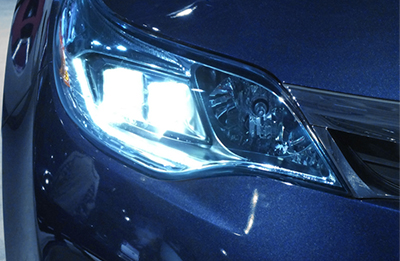Laser Headlights Have Drivers Seeing the Road in a Whole New Light
There’s been a considerable buzz about advancements in LED technology lately, but that doesn’t mean it’s the only area where light technology is developing. Laser has long been the stuff of sci-fi ray guns, reading CDs and Blu-rays and, occasionally, funny internet videos. Now laser light is being utilized in automobile headlights to increase headlight visibility and performance. This leaves a lot of consumers wondering about the effectiveness of laser headlights, their safety and their energy efficiency especially in newer hybrid vehicles.
So how do they work? Laser headlights function by using three small blue lasers pointed at a set of mirrors in the front of the headlight system. The mirrors focus the laser light into a lens filled with yellow phosphorus. Yellow phosphorus when excited by the blue laser emits an intense white light. The white light shines onto a reflector that diffuses that white light forward, shining it out the front of the headlight. This reflection and diffusion of light creates a powerful beam of light that is still safe for other driver’s eyes.
Early claims about laser headlights have estimated them to be around 1000 times brighter than LEDs (a shocking claim considering how LEDs have been taking over the automotive lighting market). If found to be true, laser headlights would be able to be designed even smaller than LEDs because the systems needed to create laser headlights are already smaller than conventional LED models. This leaves more room under the hood for automotive designers to increase engine power or use the extra space to create a more aerodynamic body.
When it comes to energy consumption, current laser headlight models also use about half the energy as LED headlights making them a great choice for electric or hybrid vehicles. This means that electric cars or hybrid cars will be able to go further by using less battery power while getting more headlight brightness. Plus many of these headlight systems can be combined with GPS data, and infrared sensors that will direct headlights around turns. The integration of sensors will enable headlights to sense people, animals or objects in the road and alert drivers ahead of time.
When will they be available on consumer model cars? Laser headlights are so far only available in Europe on two limited production German cars. It may be a while though until we see them here due to an antiquated decades-old federal regulation that requires car headlights to have only a high beam and low beam option. The laws will have to be rewritten by the National Highway Traffic Safety Administration (NHTSA) in order to make laser headlights legal for road use in the United States. However, its advantages cannot be overlooked and it’s only a matter of time before it is approved and implemented on regular production cars.











